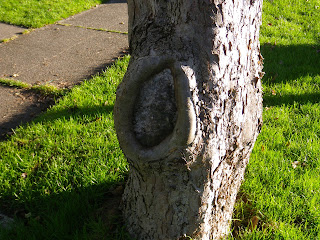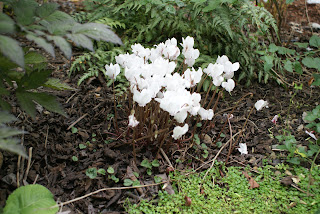~ Celia Thaxter, 1835-1894, New England poet and author of An Island Garden
The quote from Celia Thaxter above is one reason why I love gardening so. Years ago, at a particularly difficult time in my life, I stepped out my back door to begin yet another emotionally dark day. My burdens were too heavy. As I turned from the door toward the garage I heard my bubbling fountain, which caused me to look up. I hadn’t been looking up enough. I saw the sun was shining and my garden was there…in all it’s restful beauty. For a brief moment I stood there, looking and listening to the sounds of my garden and some of the burden slipped off my shoulders. I so needed that in that moment.
Everyone can experience that peace from a garden, whether it’s their own garden or a municipal garden or a park to visit. You don’t have to have acres of land or a big yard to have a garden. Many a garden is made up of pots. Big pots, small pots, lots of pots or just a few pots. The potted garden is just the thing if you are limited on time (far less weeding), space (think of balcony gardens), physical ability to reach the ground (easier digging and accessible by wheelchair) and easier to install than raised beds.
However there are some things to keep in mind if your garden is in pots.
• Water – pots can dry out faster than the ground, so you may be watering more often. You’ll need to dig down into the root area to see if the pot needs watering. Just looking at or touching the soil surface, which dries fastest, is not indicative of what the moisture level is at the roots. There are moisture meter probes available. I haven’t had the greatest success with them but they may be just the thing for you. I just worm my finger down into the soil an inch or two to test for moisture. Hanging pots or moss lined wire pots may need to be watered daily, especially if they are in windy or warm sunny places.
• Good drainage is life or death to potted plants. Roots need oxygen. Oxygen increases as soil dries out and creates air pockets. In the case of most plants if the soil never dries out, even just a little bit, the roots will drown and rot. I do not recommend keeping saucers under pots outside. The saucer will hold water which will wick back up keeping the soil too wet. Remove all saucers and if necessary add ‘pot feet’ under your pots. Pot feet lift the pot up off the ground so water will flow freely out. Depending on the surface your pots are on you may or may not need them. They come in many styles, shapes and sizes. You can buy specialty feet or just use a few bricks or flat stones. Rolling trays allow you to move your pots but if they are solid like a saucer, drill holes in them so you won’t have any sitting water. I find covering the hole with a small square of window screen material before you add the soil works better than stones or pottery chards which can shift and plug up the hole.
• Potting soil – Since I am an organic gardener I buy only potting soils and compost from organic sources. Organic soil companies are tested regularly so you can be sure you are not putting your plants into soil with petrochemicals that will leach out into your surrounding environs or taint your pot of veggies. I do not recommend any bagged soil or compost that has fertilizers added. You don’t know what they are using and the term ‘organic’ is being tossed around too freely and deceptively in the bagged soil industry. Buy your own organic fertilizers from reputable sources and add it yourself depending on the specific needs of the plant(s) in you pot. Potting soil has a neutral ph so if you have a pot for acid loving plants like blueberries, you’ll want to add some spent coffee grounds to raise the acidity level of the soil, and you’ll fertilize with an acid loving plant fertilizer.
• Fertilizer - There is no such thing as one fertilizer fits all. Depending on what you are growing, you’ll want an organic fertilizer that will boost flower and fruiting production, another to boost nitrogen for leaf production. Pots may need fertilizer added more frequently than garden beds because the available nutrients get pulled into the roots or flushed away with watering. Organic fertilizers break down more slowly than chemical fertilizers so you’ll be using a safer ingredient and fertilizing less often. Once in early spring and once in summer are enough for dry organic fertilizers, but synthetics may need to be added monthly or in 6 week intervals.
• The pots themselves – I prefer terracotta or glazed pots. I just like the look of them, but they are really heavy when filled, so they stay where they are. Terracotta can chip and crack. Every winter my terracotta pots show a bit more freeze damage. Some glazed terracotta is marketed as frost proof and will last longer with little or no damage depending on how fierce your winters are. If you need to move your pots, plastic may be perfect for you. Plastic is lighter and easier to move but deteriorates from the sun and becomes brittle over time. If your potted garden has perennials that you want to survive cold winters you’ll need to move them to protected areas. Pots do not provide the insulation from freezing to the root zone like ground soils.
 • Moving pots - even if you don’t plan to move your pots, there are times it seems it must be done. If you are not Ms/Mr. Brawny, don’t happen to have a Mr. Brawny nearby, or are too impatient to wait for him to get his act together, treat yourself to a handy hand truck. Mine is small but has a 300 pound capacity. Try to find one with bowed support rungs in the back so your pot doesn’t go sliding off as you round a corner. You may want to strap your pot to it for better security. I wouldn’t get one with inflatable tires either, they always seem to be flat when you need it most. Solid, hard rubber tires or the like are fine, and the bigger the better if you have to go over bumpy ground.
• Moving pots - even if you don’t plan to move your pots, there are times it seems it must be done. If you are not Ms/Mr. Brawny, don’t happen to have a Mr. Brawny nearby, or are too impatient to wait for him to get his act together, treat yourself to a handy hand truck. Mine is small but has a 300 pound capacity. Try to find one with bowed support rungs in the back so your pot doesn’t go sliding off as you round a corner. You may want to strap your pot to it for better security. I wouldn’t get one with inflatable tires either, they always seem to be flat when you need it most. Solid, hard rubber tires or the like are fine, and the bigger the better if you have to go over bumpy ground. May your garden be one of many sanctuaries of rest for you as mine is for me.
In Bloom In My Garden Today: sadly nothing to report
Author’s photo



















































